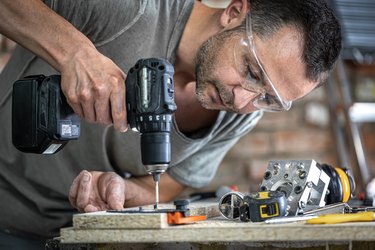
They look the same from a distance, but get closer and you'll see that a drill and a screw gun are very different tools. They have the same gun-shaped appearance, and the trigger is in the same place, but when you try to load a boring bit into a screw gun, you can't do it. It has a slotted drive shaft (SDS) chuck that only accepts hexagonal driving bits.
A screw gun has a very specific purpose, which is to drive screws. If you want to use it for boring, you need a special drill bit with a hexagonal base. For its part, a drill can double as a screw gun, but that isn't its primary purpose, so it won't drive screws as effectively. If you can purchase only one tool, make it a drill, but if you have a lot of screws to drive while installing drywall or building a deck, you'll find a screw gun to be a valuable addition to your tool collection.
Video of the Day
Video of the Day
Tip
A screw gun looks like a drill, but its sole purpose is to drive screws. You can use a drill for driving screws or boring holes, but you can't use a screw gun to bore holes.
Different Kinds of Screw Guns
Screw guns were initially marketed as drywall installation tools, and drywall screw guns are still widely available and popular. They accept a #2 Phillips driving bit that fits standard drywall screws, and they can be adjusted to sink screws just deep enough to make a dent in drywall without breaking the paper. They speed up drywall installation, and they make finishing easier by leaving an easy-to-cover depression over every screw head.
Manufacturers modified this basic design to make screw guns that could drive screws into wood, and to improve worker efficiency, they have made these guns self-loading. The screws for these collated screw guns come on plastic holders that you mount on the screw gun like you would mount clips of ammo on a machine gun. This greatly reduces the time and effort needed for simple, repetitive tasks, like installing decking boards.
An impact driver is a third type of screw gun designed for driving long screws into dense material or for extracting stuck screws. A mechanism behind the chuck develops a high-torque hammering action with each rotation of the bit. Impact driver drill bits with hexagonal bases can turn this tool into a powerful drill that can bore through dense materials.
Different Kinds of Drills
Drills have been around a lot longer than screw guns, and they have more purposes. The main difference between a drill and a screw gun is the design of the chuck. While an SDS chuck accepts only bits and drivers with hexagonal bases, a drill chuck has jaws that tighten when you rotate the chuck clockwise, so it can hold bits with round bases as well as bits and drivers with hexagonal ones. Chucks on older drills had to be tightened with easy-to-lose keys, but modern ones can be hand tightened.
The various types of drills on the market include:
All of these drills can double as screwdrivers, but in practice, using a hammer drill or a rotary hammer drill as a screwdriver would be overkill. When you need extra driving force to remove a stuck screw, for example, it's safer to use an impact driver.
Corded or Cordless Drill or Screw Gun
Drills were among the first tools to go cordless, and these days, most drills and screw guns run on batteries. Far from being inferior to corded tools, they are every bit as powerful, and most batteries can hold enough charge to run the tool for hours of continuous use. Certain powerful rotary hammer drills, right-angle drills, and collated screw guns still need a cord, but these are specialty tools that only professional tradespeople are likely to need.